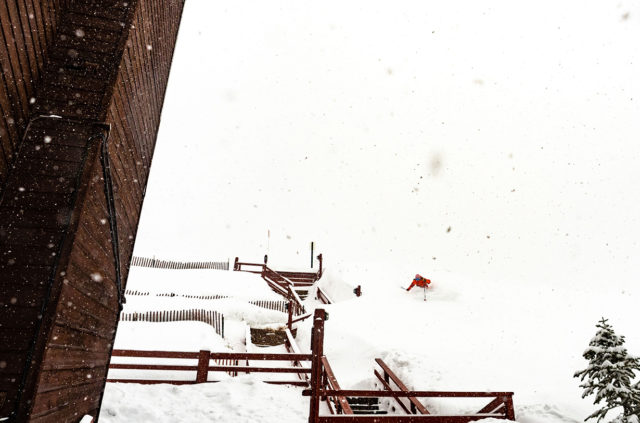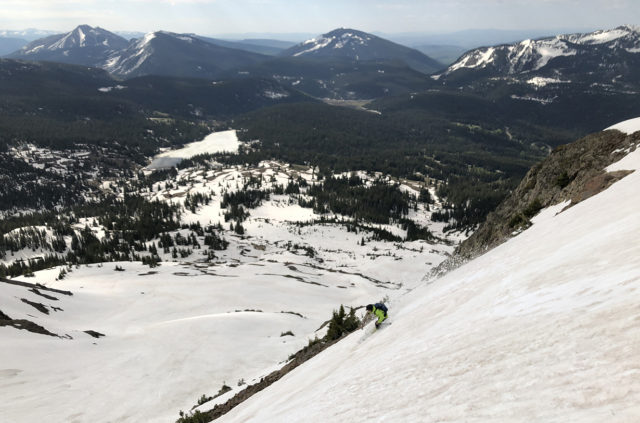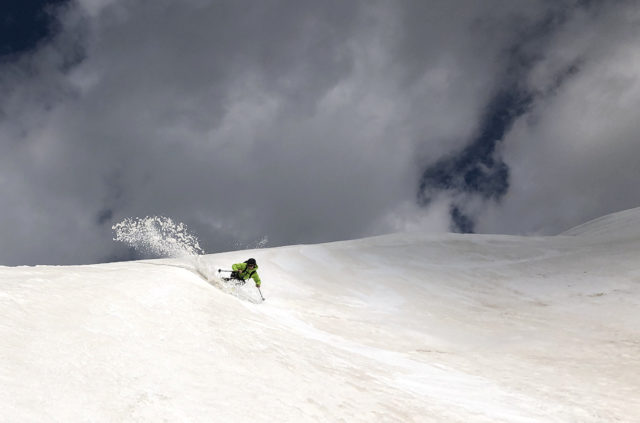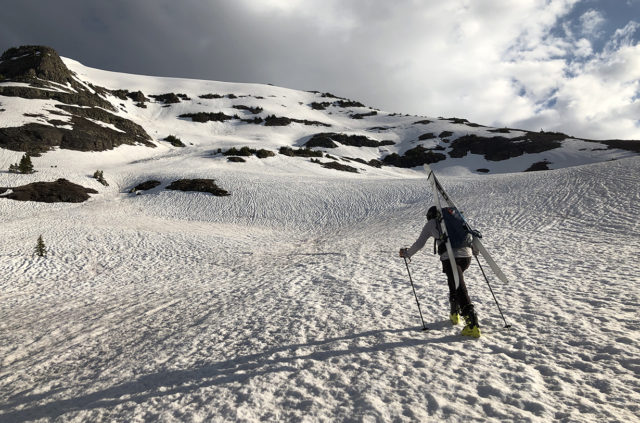Ski: 2021-2022 Line Vision 98, 179 cm
Test Location: Crested Butte, Colorado
Days Skied: ~8
Available Lengths: 172, 179, 186 cm
Blister’s Measured Tip-to-Tail Length: 178.4 cm
Stated Weight per Ski: 1515 grams
Blister’s Measured Weight per Ski: 1446 & 1447 grams
Stated Dimensions: 131-98-119 mm
Blister’s Measured Dimensions: 130.5-97.4-117.6 mm
Stated Sidecut Radius (179 cm): 18.0 meters
Measured Tip & Tail Splay (ski decambered): 64 mm / 36 mm
Measured Traditional Camber Underfoot: ~3 mm
Core: Paulownia/Maple + Carbon, Aramid, & Fiberglass Laminate
Base: 1.3 mm Sintered
Factory Recommended Mount Point: -6.0 cm from center; 83.2 cm from tail
Boots / Bindings: Tecnica Zero Tour Pro, Atomic Hawx Prime XTD 130 / G3 Zed 12
[Note: Our review was conducted on the 19/20 Vision 98, which returns unchanged for 20/21 and 21/22, apart from graphics.]

Intro
Line introduced for 19/20 a brand-new series of what they’re calling “freeride” skis, the Vision 108 and 98. Then for 20/21, they added the Vision 118. We’ve already posted our full review of the Vision 108, but now we want to take a look at the narrower Vision 98. Because based on its specs, the Vision 98 is unlike any ski we’ve seen before.
What Line says about the Vision 98
“The Vision 98 shares the same build and featherweight feel as the Vision 108– straight down to the THC Construction. It’ll rally blown snow, arc on groomers, and even motor skin tracks if that’s your thing. But the shrunken footprint offers a versatility for those days that you don’t need the float.”
In case you haven’t read our review of the Vision 108, Line’s “THC” construction basically consists of three laminates — aramid, carbon, and fiberglass. And yes, it probably not-so-coincidentally shares the same name as a certain chemical in a certain plant.
THC comments aside, it’s pretty bold of Line to claim that a ~1450-gram ski is supposed to “rally blown snow.” We haven’t been on many skis this light that encourage us to mob through rough snow, but we’ll see. It’s worth noting that Line does actually allude to touring in their description of the Vision 98, which they didn’t in their description of the Vision 108. Given that both skis come in at weights comparable to most dedicated touring skis, we’ll definitely be putting time on them in the backcountry.
Shape / Rocker Profile
The Vision 98 and 108 have very similar shapes and rocker profiles. The Vision 98 has slightly less tip and tail taper compared to the Vision 108, but the Vision 98 has more tail taper than most touring skis in its class like the Salomon MTN Explore 95, Blizzard Zero G 95, K2 Wayback 96, and G3 FINDr 102. Up front, the Vision 98’s tips are less tapered, and its tips aren’t nearly as tapered as skis like the Dynastar Mythic 97, Faction Prime 2.0, or 4FRNT Raven.
The Vision 98 has a lot of rocker for a 98mm-wide ski, with both its tip and tail rocker lines extending pretty deep into the ski. It also has a lot of tail splay, and you could probably even call its tail a “twin.”
But like the 108, the Vision 98’s rocker lines are low and pretty subtle, rather than rising abruptly like those on skis like the Mythic 97 and Raven. So it looks like the Vision 98 should do pretty well in soft snow, and we’re curious to see how it does on firmer snow, especially since it sits on the narrower end of the spectrum.
Flex Pattern
Here’s how we’d characterize the flex pattern of the Vision 98:
Tips: 5.5-6
Shovels: 6.5-7
In Front of Toe Piece: 7.5-9
Underfoot: 9.5
Behind the Heel Piece: 9-8.5
Tails: 7.5
The Vision 98’s flex pattern feels very similar to the Vision 108’s. Both skis have soft tips and shovels, and then their flex patterns slowly ramp up as you move to the middle of the ski. The Vision 98’s tails are ever so slightly softer than the 108’s, and the Vision 98’s flex pattern ramps up a bit quicker than the 108’s. The Vision 98’s tails are a bit stiffer than its tips, but the difference isn’t as dramatic as more directional skis like the MTN Explore 95 and Mythic 97.
Compared to the MTN Explore 95, Mythic 97, and Wayback 96, the Vision 98’s tips are similarly soft, but the Vision 98’s tails are notably softer, and the Vision 98’s flex pattern ramps up a bit slower overall. The Vision 98 is far from a super stout ski, but its flex pattern does feel pretty round and ramps up without any noticeable hinge points, which we like.
Mount Point
Along with its deep rocker lines, the Vision 98’s mount point is another thing that sets it apart from other similarly light skis. Pretty much all of the skis currently on the market that come in this light have very traditional mount points (often -9 cm from center or further back).
But the Vision 98’s mount point of -6 cm from center is much more progressive, and we think skiers who tour a lot but who also ski with more of a centered stance should take note of this.
Weight
Of the skis we’ve reviewed, the 179 cm Vision 98 is one of the lightest. Not just in its width class, but overall. It’s really light.
That said, it’s not that far off in terms of weight from some very good skis like the Salomon MTN Explore 88 & 95, Dynastar Mythic 97, and Black Diamond Helio 105 Carbon. But we definitely consider all of those skis to be touring skis, rather than what we’d typically call “freeride” skis that you’d use in the resort. So will our position change with the Vision 98? We doubt it, but we’re eager to find out.
For reference, here are a number of our measured weights (per ski in grams) for some notable skis. Keep in mind the length differences to try and keep things apples-to-apples.
1250 & 1256 Fischer Transalp 90 Carbon, 176 cm (18/19–19/20)
1353 & 1358 Majesty Werewolf CLT, 184 cm (17/18–19/20)
1353 & 1376 Blizzard Zero G 95, 185 cm (17/18–18/19)
1390 & 1439 Salomon MTN Explore 88, 184 cm (16/17–19/20)
1446 & 1447 Line Vision 98, 179 cm (19/20)
1469 & 1477 K2 Wayback 96, 177 cm (18/19–19/20)
1476 & 1490 K2 Wayback 106, 179 cm (18/19–19/20)
1477 & 1482 G3 FINDr 102, 184 cm (17/18–18/19)
1507 & 1595 Salomon MTN Explore 95, 184 cm (16/17-18/19)
1512 & 1523 Dynastar Mythic 97, 184 cm (17/18–19/20)
1547 & 1551 Black Diamond Helio 105 Carbon, 185 cm (17/18)
1562 & 1566 Scott Superguide 105, 183 cm (17/18–18/19)
1605 & 1630 Line Vision 108, 183 cm (19/20)
1606 & 1641 Blizzard Zero G 105, 188 cm (19/20)
1629 & 1684 Elan Ripstick 96, 181 cm (17/18–18/19)
1633 & 1638 Faction Prime 2.0, 184 cm (18/19–19/20)
1642 & 1651 Renoun Citadel 106, 185 cm, (18/19)
1680 & 1707 Line Sick Day 94, 186 cm (17/18–19/20)
1706 & 1715 Volkl BMT 109, 186 cm (17/18–19/20)
1720 & 1747 Line Sick Day Tourist, 186 cm (16/17)
1734 & 1750 Renoun Endurance 98, 184 cm (18/19)
1745 & 1747 4FRNT Raven, 184 cm (16/17–18/19)
Some Questions / Things We’re Curious About
(1) The Vision 98 is really light, and as with any really light ski, we’re very curious to see how well the Vision 98 balances low weight with downhill performance.
(2) We’ve never reviewed a ski that’s as light as the Vision 98 but that comes with a similarly progressive mount point and dramatic rocker profile. It seems like it should cater well to more playful skiers, so … will it?
(3) Line is marketing the Vision series as “freeride” skis, but they come in at weights much more comparable to dedicated touring skis. So should the Vision 98 be thought of as a dedicated touring ski, a 50/50 ski, or one that you could feasibly use in the resort?
Bottom Line (For Now)
The Line Vision 98 certainly stands out in the current market. It’s got the weight of ultralight touring skis, but unlike those skis, the Vision 98 has a lot of rocker, a fairly round flex pattern, and a progressive mount point. We’ve never seen anything like it, and we’re excited to spend time on it. Stay tuned for updates.
Flash Review
Blister Members can now check out our Flash Review of the Vision 98 for our initial impressions. Become a Blister member now to check out this and all of our Flash Reviews, plus get exclusive deals and discounts on skis, and personalized gear recommendations from us.
FULL REVIEW
I’ve now had the Vision 98 in everything from deep powder to horrible, mid-July “snow.” In our First Look, we said that the Vision 98 looked unlike anything else in its class, and after skiing it, I think that’s still true. It won’t be for everyone, but we’ll try to sum up here who we think will get along well with this ski.
Powder
At 98 mm underfoot, this isn’t really a ski designed to excel in deep snow, but I do think it does very well for its size. Compared to most similarly narrow skis, the Vision 98’s fairly soft, wide, and rockered shovels plane up in deep snow very easily and the ski remains very easy to slash and pivot through soft snow. All in all, the Vision 98 is one of the better ~98mm-wide skis I’ve used in terms of flotation and maneuverability in pow, and I think it’d be particularly appealing to those who ski with a more centered stance in deep snow / are accustomed to skis with more forward mount points.
I’ve been skiing the 179 cm Vision 98, which is a bit on the shorter side for me (I’m 5’8”, 155 lbs), and I found that I needed to ski it a bit more centered in deep snow, with less pressure on the shovels and the front of my boots, compared to some similarly wide and long skis with more rearward mount points and / or stiffer flex patterns.
That said, for a ski that I’m using in the backcountry (where I don’t tend to ski super fast and aggressively), I find that a more relaxed, neutral stance in powder is fine by me. Especially in variable backcountry conditions where the snow might transition from blower pow to firm sastrugi, I usually tend to take this more centered approach regardless of what ski I’m on.
But an important takeaway here is that, if you’re looking for a ~98mm-wide, ultralight ski that you can really drive through deep snow, this probably isn’t your ski.
Fortunately, nearly all of the other skis in this class that are as light as the Vision 98 do support a more aggressive stance in deeper snow, so it’s not like you are short on options.
Chop, Crud, & Variable Snow
Let’s get this out of the way: this is not a stable ski. It weighs less than 1500 grams per ski for the 179 cm length, and it’s not very stiff. Even in soft chop and fairly forgiving, but inconsistent snow conditions (like slushy suncups), the Vision 98 requires a very active, light-on-your-feet style to ski fast. And really, this is just a ski that feels best at slower speeds when the snow is rough.
The upside with the Vision 98 is that it has a huge sweet spot, it’s extremely easy to flick around, and it feels loose and surfy. In other words, it’s very well suited to skiing at slower speeds, even when you’re not driving the front very hard.
So, in case it wasn’t clear simply based on the weight of the Vision 98, this is not a ski for people who want to ski hard in variable snow, especially not in the resort.
But for how extremely light it is, I will say the Vision 98 offers good stability and suspension. Especially compared to similarly light skis, the Vision 98 lacks that harsh, “pingy” feel often found in ultralight, carbon-laminate touring skis. It’s just that the “for how extremely light it is” qualifier is very important — the Vision 98 is one of the lightest skis we’ve ever weighed.
Groomers & Smooth, Firm Snow
On smooth, consistent snow, the Vision 98 is actually a lot of fun. It’s pretty easy to get on edge, provides good edge hold when the groomers are smooth, and is extremely energetic.
As in more variable snow, I don’t feel like skiing the Vision 98 very fast on firm snow. While it’s predictable when that firm snow is smooth, it also chatters a lot when you need to shut it down, so I found that sticking to GS turns or smaller turns let me enjoy the nice carving performance of the Vision 98 without getting scared when I needed to quickly shut things down.
It’s also worth noting that on shallower and / or firmer snow, you can drive the Vision 98 pretty hard through the shovels. Again, this isn’t the ski for super aggressive, directional skiers, but it’s a lot of fun to carve, especially smaller turns. And for a backcountry ski, where I almost never make turns larger than GS size anyway, that makes the Vision 98 a lot of fun on things like windbuff, snow that hasn’t quite warmed up to real corn, chalk, or other fairly firm, smooth conditions.
On steep, firm terrain like spring couloirs where you didn’t nail the corn-cycle timing, the Vision 98 is predictable, but many of the more directional, traditional skis in this class offer better edge hold. So while I’ve gotten down some steep, consequential lines on this ski, it wouldn’t be my first choice for that particular end use.
Corn
Apart from pow, this is my favorite condition to ski on the Vision 98. On forgiving snow like corn, the low weight of the Vision 98 isn’t as noticeable, and I had a ton of fun arcing fast turns on the Vision 98 in wide-open fields of thawed, spring snow.
There are a few more directional options in this class (of very lightweight, ~98mm-wide skis) that I feel like I can push harder in corn, but the difference is much less pronounced than on firmer conditions. And, unlike those more directional skis, the Vision 98 is super easy to throw sideways and throw up a bunch of snow, in case you’re into that kind of thing…
Playfulness
This is one of the big areas where the Vision 98 stands out from nearly every other similarly lightweight ski. The Vision 98 is not very stiff, it doesn’t have a flat tail, it’s got a pretty forward mount point, and it has pretty deep rocker lines. All of this equates to a very playful ski.
You can ski the Vision 98 very centered if you want, it’s almost ludicrously light in the air, it skis switch pretty well, it requires very little input to throw sideways, and it’s super poppy. You can still drive the Vision 98 through the shovels when you want (especially in shallower conditions), but it’s so much more playful than all the other similarly light skis we’ve used. That’s a big part of why I like it so much, and why I think it will be appealing to skiers who want a very lightweight touring ski but who also want to be able to ski with a more playful style in the backcountry.
Who’s It For?
Skiers who want a very lightweight ski, but who don’t want a super directional ski that demands an aggressive, forward stance all the time.
If you’re specifically looking for a touring ski that will primarily be used on steep, consequential lines in firm conditions, you’ve got several other options that are more supportive and offer better edge hold on straight-up ice (see the “Backcountry Touring” section of our Winter Buyer’s Guide).
And if you’re only planning on using this ski in the resort, I think the vast majority of people will be better off on an even slightly heavier ski (see the “All-Mountain More Forgiving” section of our Winter Buyer’s Guide).
For those people looking for a ski that they’ll use both in the backcountry and the resort, the Vision 98 could work, but it comes down to your priorities. If you want this ski to hold up to aggressive skiing in rough conditions, we’d recommend going with something heavier like Line’s own Sick Day 94. If you don’t mind skiing very conservatively in rougher conditions in the resort, the Vision 98 could work, particularly if your “50/50” ski will actually see a “70/30,” “80/20,” or “90/10” ratio of backcountry to resort skiing.
But I think the Vision 98 makes the most sense as a dedicated touring ski. It’s so, so light on the uphill, and performs quite well in forgiving backcountry conditions like corn and powder. And when you get it on crappy snow, I think the Vision 98’s suspension / damping is quite good for just how light it really is. Compared to other skis in this class, the Vision 98 really stands out for those skiers who want to bring a more playful style to the backcountry, or who just appreciate an easier, more forgiving ski for touring.
Bottom Line
The Line Vision 98 is an extremely lightweight ski that doesn’t look or perform like other extremely lightweight skis. It’s very forgiving, very playful, and very easy to ski, but light enough for long days in the backcountry. Aggressive directional skiers will be better served by the more traditional options in this category, but the Vision 98 offers something different that has previously been absent from this category.
Deep Dive Comparisons
Become a Blister Member or Deep Dive subscriber to check out our Deep Dive comparisons of the Vision 98 to see how it compares to the Salomon MTN Explore 95, K2 Wayback 96, Dynastar Mythic 97, Armada Tracer 98, G3 FINDr 102, 4FRNT Raven, & Line Vision 108.





Why are the bases white… Kinda ruins it for me, unfortunately
Seems like the Kitten Factory Toors Lite in a 176cm would be close on paper to a 179cm Vision 98? I know Cy reviewed the Toors Lite awhile back but I haven’t seen it any Blister deep dives or spectrums since then.
The category of 1500-1700 gm skis with mount points of -2cm to -6cm seems like it has grown exponentially in the last two years. I’m hoping you guys do a “progressive mount touring ski” deep dive this season!
Really gratified how these came out and glad they’re in your hands early for deep testing. Sorry for the shameless plug BUT there is a limited quantity available to shop employees & VIPs now if you’re looking for a late-season refresh. USA regional sales reps would accommodate a code. -josh
Hey Josh,
Do you have a rep email for someone in the Tahoe area? Thanks!
just DM-ed ya .. on FB (because I can’t figure out how to on here)
Hey bud. Any chance for an average joe like me?
taylormargot@gmail.com
On my 10th day on my visions they completely delaminated underfoot. No crash or anything. Season cut short even before corona..
I like the idea of a rockered somewhat surfier ski in this width…if only it was 200 grams heavier with a corresponding increase in stability and shock absorption….
How stable is this compared to the salomon mountain explorer 95?
Check out our Deep Dive for that comparison: https://blisterreview.com/deep-dive/deep-dive-line-vision-98
Great review, Luke. My experience with Vision 98 is very similar to yours. I just wanted to add that it pairs really well with a softer, lightweight touring boot like the Dynafit TLT7. I am really appreciating the advantages of this lightweight setup over a long day of touring, and finding fewer and fewer days where I think I need a wider, heavier ski and stiffer, heavier boot.
Sweet! Yeah I think this ski would be a great pairing for lighter boots since it’s comfortable being skied without a ton of pressure on the front of your boots anyways, in which case something like the TLT7 seems like an awesome combo.
As stated above, my ski also delaminated underfoot on my second day using these, on a mellow groomed run no less. It’s a shame because I was really enjoying the ride otherwise. Warranty process was a hassle as well, I’m out about $100 between the binding mount and Line (ahem, K2) making me pay the return shipping for the skis to be warrantied. Little to no email correspondence from the company as well. Pretty disappointing.
Any advice on mount point for dedicated touring with light 2 buckle boots? Sounds like -2 or even -4cm from rec line could be better for powder.
Same question.. . I will use these for ski touring only… A lot of powder days but not deep about 5 to 10 cm untracked and tree skiing. Using Marker Alpinist 12 binding and technica zero guide pro boots. I would love advice on mount point – 6 cm seems too centered for my use. What would you recommend?
hey Im 14 and just picked up a pair of these used as my touring ski along with a moment Deathwish for resort. im mounting them up with a pair of Dynafit rotation 12s that I got on sale would you recommend -6 as my mount point? im 135 and 6ft.
As two people have mentioned, my ski’s topsheet got delaminated at the underfoot. It took ONE RUN. Brutal ski.
I had not one, not two, but THREE of these skis completely explode underfoot. more than just a delam, the entire core tore apart. methinks they made this ski too light for its own good. I have another warranty pair but honestly I’m too scared to ski on these anymore
FOR THE LOVE OF GOD, DONT BUY THESE SKIS. These skis are trash! 0 stars. They are super lightweight, but don’t expect to be able to push these skis, I had a pair of 2020 Vision 98, which delaminated underfoot. That ski had only seen the mountain 6 times. Line warranty sent me a 2021 Vision 98, and after 4 trips to the mountains they delaminated as well, in the same spot. That’s two pairs of these skis in less than one calendar year.
LINE DID NOT WARRANTY MY SKIS FOR THE DELAMINATION, DESPITE THEIR 2 YEAR DELAMINATION WARRANTY.
I don’t know who these skis are marketed to, but if you like to do more than go straight down groomed slopes, stay away!!
Any comparison to La machine mini, or Volkl Blaze 94?
We haven’t skied them, but I suspect the Vision 98 would be more maneuverable, playful, and forgiving than La Machine Mini, while the Mini would probably hold an edge a bit better and maybe be a touch more stable when making bigger, faster turns.
Similar story with the Blaze 94, though the Blaze 94 would probably be the most stable and least maneuverable / playful of the three.